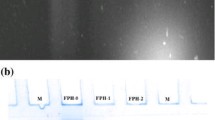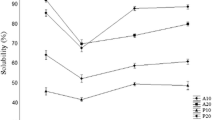Abstract
Fish protein hydrolysate (FPH) was prepared from fresh water fish Cirrhinus mrigala using papain and dried in oven (OD-FPH) and freeze dryer (FD-FPH). The electron micrographs of FD-FPH samples showed porous structure. The browning intensity of OD-FPH samples was higher than the FD-FPH samples. The DPPH (2, 2 Diphenyl-1-picrylhydrazyl) free radical scavenging activity and linoleic acid peroxidation inhibition activity of FPH were not affected by oven drying process. The sequential digestion of FPH with pepsin and pancreatin reduced the antioxidant properties in both OD-FPH and FD-FPH samples. The solubility of proteins in OD-FPH was lower at pH 5 while for that of FD-FPH it was at pH 7 with water as solvent. The surface active properties of FD-FPH samples were higher than OD-FPH samples. The oven drying of fish protein hydrolysates may be advocated considering the properties and cost of production.





Similar content being viewed by others
References
Agyei D, Danquah K (2011) Industrial-scale manufacturing of pharmaceutical-grade bioactive peptides. Biotechnol Adv 29:272–277
Chen C, Chi YJ, Xu W (2012) Comparisons on the functional properties and antioxidant activity of spray-dried and freeze-dried egg white protein hydrolysates. Food Bioprocess Technol 5:2342–2352
D’Hondt M, Demaré W, Dorpe SV, Wynendaele E, Burvenich C, Peremans K, Spiegeleer BD (2011) Dry heat stress stability evaluation of casein peptide mixture. Food Chem 128:114–122
Damodaran S (1997) Protein-stabilized foams and emulsions. In: Damodaran S, Paraf A (eds) Food proteins and their applications. Marcel Dekker, New York, pp. 57–110
Elavarasan K, Shamasundar BA (2014) Angiotensin I-converting enzyme inhibitory activity of protein hydrolysates prepared from three freshwater carps (catla catla , labeo rohita and cirrhinus mrigala) using flavorzyme. Int J Food Sci Technol 49:1344–1350
Elavarasan K, Naveen Kumar V, Shamasundar BA (2014) Antioxidant and functional properties of fish protein hydrolysates from fresh water carp (catla catla) as influenced by the nature of enzyme. J Food Process Preserv 38:1207–1214
Foh MBK, Kamara MT, Amadou I, Foh BM, Wenshui X (2011) Chemical and physicochemical properties of tilapia (Oreochromis niloticus) fish protein hydrolysates and concentrate. Int J Biol Chem 5:21–36
Keppel G, Wickens TD (1973) Design and analysis: a researcher’s handbook. Prentice-Hall, Inc, Englewood Cliffs
Khantaphant S, Benjakul S, Kishimura H (2011) Antioxidative and ACE inhibitory activities of protein hydrolysates from the muscle of brownstripe red snapper prepared using pyloric caeca and commercial proteases. Process Biochem 46:318–327
Klompong V, Benjakul S, Kantachote D, Shahidi F (2007) Antioxidative activity and functional properties of protein hydrolysate of yellow stripe travelly (selaroides leptolepis) as influenced by the degree of hydrolysis and enzyme type. Food Chem 102:1317–1327
Klompong V, Benjakul S, Kantachote D, Hayes KD, Shahidi F (2008) Comparative study on antioxidative activity of yellow stripe trevally protein hydrolysate produced from alcalase and flavourzyme. Int J Food Sci Technol 43:1019–1026
Ktari N, Jridi M, Bkhairia I, Sayari N, Salah RB, Nasri M (2012) Functionalities and antioxidant properties of protein hydrolysates from muscle of zebra blenny (salaria basilisca) obtained with different crude protease extracts. Food Res Int 49:747–756
Ladikos D, Lougovois V (1990) Lipid oxidation in muscle foods: a review. Food Chem 35:295–314
Lawal OS (2004) Functionality of African locust bean (parkia biglobossa) protein isolate: effects of pH, ionic strength and various protein concentrations. Food Chem 86:345–355
Liu Y, Li X, Chen Z, Yu J, Wang F, Wang J (2014) Characterization of structural and functional properties of fish protein hydrolysates from surimi processing by-products. Food Chem 151:459–465
Lo WMY, Farnworth ER, Li-Chan ECY (2006) Angiotensin I-converting enzyme inhibitory activity of soy protein digests in a dynamic model system simulating the upper gastrointestinal tract. J Food Sci 71:S231–S237
Lowry OH, Rosebrough NJ, Farr AL, Randall RJ (1951) Protein measurement with the folin phenol reagent. J Biol Chem 193:265–275
Mitsuda H, Yasumoto K, Iwami K (1966) Antioxidation action of indole compounds during the autoxidation of linoleic acid. Eiyoto Shokuryo 19:210–214
Nalinanon S, Benjakul S, Kishimura H, Shahidi F (2011) Functionalities and antioxidant properties of protein hydrolysates from the muscle of ornate threadfin bream treated with pepsin from skipjack tuna. Food Chem 124:1354–1362
Nesse KO, Nagalakshmi AP, Marimuthu P, Singh M (2011) Efficacy of a fish protein hydrolysate in malnourished children. Indian J Clin Biochem 26:360–365
Nimse SB, Pal D (2015) Free radicals, natural antioxidants, and their reaction mechanisms. RSC Adv 5:27986–28006
Osawa T, Namiki M (1985) Natural antioxidants isolated from eucalyptus leaf waxes. J Agric Food Chem 33:777–780
Oyaiza M (1986) Studies on products of browning reactions: antioxidative activities of products of browning reaction prepared from glucosamine. Jpn J Nutr 44:307–315
Pearce KN, Kinsella JE (1978) Emulsifying properties of proteins evaluation of a turbidimetric technique. J Agric Food Chem 26:716–723
Sathe SK, Salunkhe DK (1981) Functional properties of the great northern bean (Phaseolus vulgaris L.) proteins: emulsion, foaming, viscosity and gelation properties. J Food Sci 46(71–74):81
Schmid FX, (2001) Biological Macromolecules: UV-visible Spectrophotometry. In Encyclopedia of Life Sciences; Macmillan Publishers Ltd.: Nature Publishing Group
Tang WL, Zang M, Adhikari B, Mujumdar AS (2013) Effects of preparation and drying methods on the antioxidant activity of enzymatically hydrolysed porcine placenta hydrolysates. Dry Technol 31:1600–1610
Thiansilakul Y, Benjakul S, Shahidi F (2007) Compositions, functional properties and antioxidative activity of protein hydrolysates prepared from round scad (decapterus maruadsi). Food Chem 103:1385–1394
Yen GC, Wu JY (1999) Antioxidant and radical scavenging properties of extracts from ganoderma tsugae. Food Chem 65:375–379
Zeng Q, Zhang M, Adhikari BP, Mujumdar AS (2013) Effect of drying processes on the functional properties of collagen peptides produced from chicken skin. Dry Technol 31:1653–1660
Acknowledgments
The financial support provided by European Union, Brussels under FP-7, SECUREFISH (Grant No.289282) for conducting the research work is gratefully acknowledged.
Author information
Authors and Affiliations
Corresponding author
Additional information
Highlights
• Browning intensity of oven dried fish protein hydrolysate was higher.
• Antioxidant properties of fish protein hydrolysate was not affected by oven drying process
• Simulated gastrointestinal digestion reduced antioxidant properties of FPH
• Freeze dried hydrolysates possessed better surface active properties
Rights and permissions
About this article
Cite this article
Elavarasan, K., Shamasundar, B.A. Effect of oven drying and freeze drying on the antioxidant and functional properties of protein hydrolysates derived from freshwater fish (Cirrhinus mrigala) using papain enzyme. J Food Sci Technol 53, 1303–1311 (2016). https://doi.org/10.1007/s13197-015-2084-9
Revised:
Accepted:
Published:
Issue Date:
DOI: https://doi.org/10.1007/s13197-015-2084-9




